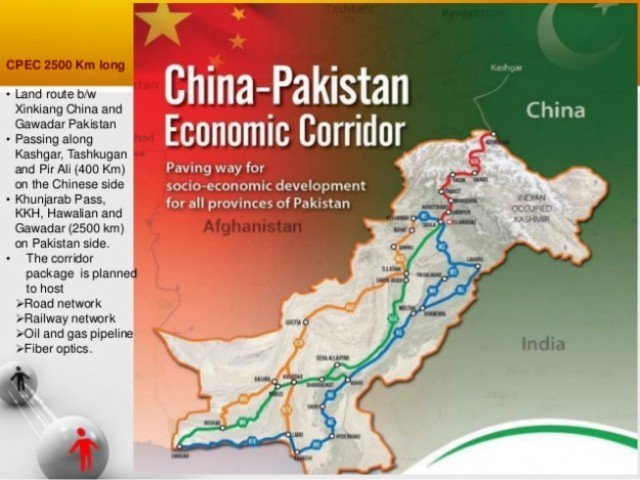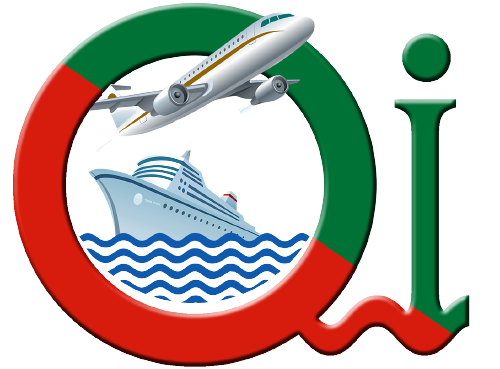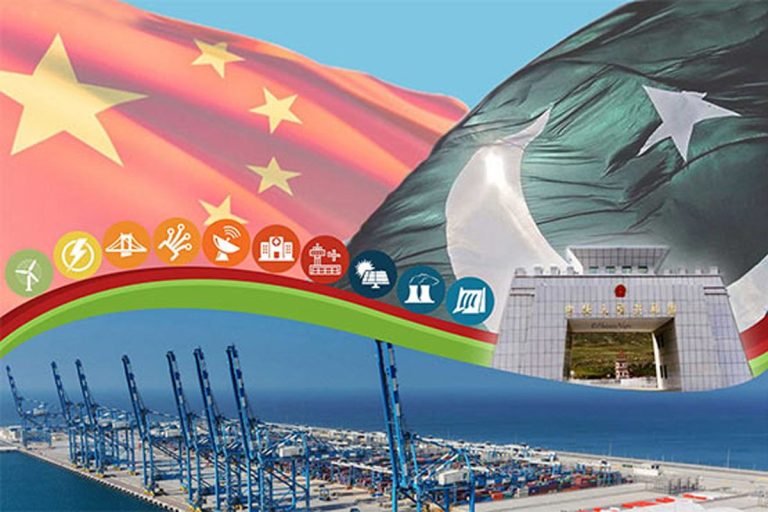The China-Pakistan Economic Corridor (CPEC) is a 3,000-kilometer network of roads
It enters Pakistan from Kashgar in the Xinjiang area of northwest China and connects the Arabian Sea via Gwadar, allowing Chinese goods to reach the Middle East, Africa, and beyond. This includes the 1,300-kilometer Karakoram Highway.
In the 1950s, initiatives to connect the Chinese border with the Arabian Sea began. The Karakoram motorway was built starting in 1959. This road was later connected to other constructions. Gwadar Port’s construction began in 2002 and was finished in 2006. Following that, due to political uncertainty in Pakistan and an increase in terrorist attacks, the expansion of the Gwadar port was briefly halted.
Pakistan and China committed to strengthen bilateral ties in 2013, and a Memorandum of Understanding for a long-term China-Pakistan Economic Corridor project was inked in 2013. During his visit to Pakistan in April 2015, Chinese President Xi Jinping remarked in an editorial, “This will be my first visit to Pakistan, yet I feel like I’m going to my own brother’s house.” Pakistan and China struck a $46 billion investment agreement on 20 April 2015, equaling around 20% of Pakistan’s yearly GDP. On 12 August 2015, the two countries inked 20 new agreements totaling $1.16 billion to broaden the scope of C-Pac, with an emphasis on growing energy-producing capacity. Pakistan and China also agreed to cooperate in the field of space exploration as part of the pact.
The UK government announced two different funds to the Government of Pakistan in September and October 2015 for the development of roads that are critical for C-Pack. C-Pac was included in China’s 13th -Year Development Plan in November 2015, and China and Pakistan agreed to invest an additional 1.5 billion in the project’s Information and Technology Park in December 2015. . China and Pakistan announced new deals totaling $2 billion on April 8, 2016, covering infrastructure, solar energy, and logistics programmers.
On 13 November 2016, the first Chinese convoy arrived in Gwadar, thereby launching the C-Pack operation. The first cargo train connecting China and Pakistan inaugurated a direct rail and marine freight service from Greece on 2 December 2016. A cargo train carrying 500 tonnes of products left Kunming for Guangzhou, where it was shipped to Karachi by cargo ship, paving the way for a new trade route.
In November 2016, China pledged an extra $5.8 billion investment in Pakistan, with $4.45 billion earmarked for the track, speed, and signal upgrades on Pakistan’s main railway line from Karachi to Peshawar. To assist alleviate energy shortages, $4 billion has been set aside for LNG terminals and transmission systems.

In March 2017, an agreement was made for the following projects:
In March 2017, an agreement was made for the following projects:
1. Oil refinery worth 1.1.5 billion $1.5 billion $1.5 billion $1.5 billion $1.5 billion $1.5
2. Irrigation projects worth $2. 2 billion
3. Between Chitral and DI Khan, a $3.22 billion highway is being built.
4. Hydroelectric projects worth $7 billion
5. Gwadar Port Complex is a port complex in Gwadar, Pakistan.
The Gwadar port was initially improved under the C-Pac agreement to allow larger vessels to arrive. One of the port’s improvement projects is the development of a 130-million-dollar breakwater liquefied natural gas facility. It will have a daily capacity of 500 million cubic feet of liquefied natural gas and will be connected to the Iran-Pakistan gas pipeline’s Gwadar Nawabshah leg.
The new port is near Gwadar’s 2282-acre free trade zone, which is modeled after China’s special economic zones. The 43-year lease was turned over to China Overseas Port Holding Company in November 2015. A production zone, logistical hub, warehouse, and show center are all located on the property. Many provincial and federal taxes, including customs, will be waived for businesses in the zone. For the next 23 years, businesses in the special economic zone will be immune from federal excise taxes.
Contractors and subcontractors linked with China Overseas Port Holding Company will be exempt for 20 years, while imports of equipment, materials, plant/machinery, equipment, and accessories to Gwadar Port and special economic zones would be exempt for 40 years. In three stages, the special economic zone will be finished. The development of a new international airport in Gwadar has been budgeted at $0 230 million. The city of Gwadar will be developed further with the construction of a 300 MW coal-fired power station, a desalination facility, and a new 300-bed hospital, all of which are now underway. It will run between Gwadar Port to Makran Coastal motorway. The cost of these extra projects is expected to be over 800 million dollars.
Pakistan is receiving financial help from China’s Exim Bank in the form of interest-free loans. In Gwadar, a training institute known as the Pak-China Technical and Vocational Institute has been established. Gwadar’s expansion also includes the construction of a hospital, which is funded by a Chinese government grant. Medical blocks, medical equipment, and machinery, as well as Nursing and Paramedical Institute, Medical College, Central Laboratory, and other relevant facilities, are all part of the proposed project. Planned improvements to Pakistan’s transportation infrastructure are critical.

Three cargo transportation corridors have been identified:
1. Sindh and Punjab’s eastern road network, which is home to the majority of the country’s industry.
2. The Western Network will link Khyber Pakhtunkhwa and Balochistan’s less developed and less populated districts.
3. A central network that will run through KPK, Punjab, and Balochistan.
1: Eastern Network:
Surprisingly, the Karakoram motorway already connects China and Pakistan. At the Shah Maghsoud Interchange, the existing M-1 motorway will meet the N35. As part of the existing M1 and M2 motorways, access to Islamabad and Lahore is already in place.
The Karakoram motorway between Burhan and Raikot is being improved across a 487-kilometer stretch. After completion, the 59-kilometer, four-lane expressway between Burhan and Havelian at the southern end of the N35 will be known as the E35 expressway.
Between Villain and Shankiari, a 66-kilometer route north of Havelian will be transformed into a four-lane dual carriageway. A two-lane highway will be built along the full 354 km stretch north of Shankiari and terminating at Raikot near Chilas. The development of the Diamer Bhasha Dam and the Dasu Dam in the Thakot-Raikot area is critical.
The Eastern Road Network of C-Pak encompasses road projects in Sindh and Punjab. The 1152 km long motorway connects Pakistan’s two biggest cities, Karachi and Lahore, to the east. The total cost of the project was approximately $6.66 billion. The Eastern Motorway is broken down into four sections.
1. The M9 Motorway, which runs for 136 kilometers between Karachi and Hyderabad.
2. A 345-kilometer portion between Hyderabad and Sukkur, and a 392-kilometer section between Sukkur and Hyderabad
3. A 333-kilometer stretch connecting Multan and Lahore (via Abdul Hakim town)
2. Western network of Motorway:
In Balochistan, Khyber Pakhtunkhwa, and West Punjab, major road improvement projects are underway. Parts of the route will be expanded to a six-lane motorway in the future. In Balochistan Province’s 870 km long road reconstruction project, 620 km of hedges have already been replaced. The Western Network will begin near the towns of Burhan and Hassan Abdal in North Punjab, at the Brahma Better Interchange on the M1 Motorway. There are 11 interchanges, 74 culverts, and three significant bridges on the route.
The N50 National Highway in Khyber Pakhtunkhwa has also been improved between Dera Ismail Khan and Balochistan Zhob. The N25 will stretch south from Quetta to the central Balochistan town of Sorab. The N85 highway, which would run for 470 kilometers from Sorab to Hoshab in southern Balochistan, near Turbat, will connect central and western Balochistan. A freshly constructed 193-kilometer segment of the M8 Motorway connects the towns of Hoshab and Gwadar.
3: Central network of motorway:
The 184-kilometer M-4 motorway between Faisalabad and Multan is not covered by the C-Pack projects, although it is nevertheless crucial for the C-Pack transportation scheme. The Karakoram Highway, officially known as the E-35 Motorway, will be upgraded south of Mansehra city. C-Pack money is not being used to fund the E35. The United Kingdom will contribute $121.6 million to the Asian Development Bank.
More blogs to read





Boost your income—enroll in our affiliate program today! https://shorturl.fm/zdHFo
Start earning instantly—become our affiliate and earn on every sale! https://shorturl.fm/e183A
Join our affiliate community and maximize your profits—sign up now! https://shorturl.fm/CEvaE
Join our affiliate community and maximize your profits! https://shorturl.fm/lU7Sp
Share your link and rake in rewards—join our affiliate team! https://shorturl.fm/yB0th
Join our affiliate community and earn more—register now! https://shorturl.fm/jS0zr
Share your unique link and cash in—join now! https://shorturl.fm/E0w5f
Share your link and rake in rewards—join our affiliate team! https://shorturl.fm/2wcdR
Refer and earn up to 50% commission—join now! https://shorturl.fm/v4IwW
Boost your profits with our affiliate program—apply today! https://shorturl.fm/e33sX
Unlock exclusive rewards with every referral—apply to our affiliate program now! https://shorturl.fm/CNMy9
Join our affiliate program today and start earning up to 30% commission—sign up now! https://shorturl.fm/hIRlv
Boost your income—enroll in our affiliate program today! https://shorturl.fm/2fuAp
Get rewarded for every recommendation—join our affiliate network! https://shorturl.fm/e0rlP
https://shorturl.fm/mZThu
https://shorturl.fm/1H1kh
https://shorturl.fm/Y3vOR
https://shorturl.fm/pWtKF
https://shorturl.fm/JyUpt
https://shorturl.fm/wiM7k
https://shorturl.fm/Yki9O
https://shorturl.fm/UpkjM
https://shorturl.fm/BetfB
https://shorturl.fm/L133B
https://shorturl.fm/HklUS
https://shorturl.fm/sMiGc
https://shorturl.fm/YSicD
https://shorturl.fm/yysMJ
https://shorturl.fm/7WDeo
https://shorturl.fm/j1yjN
https://shorturl.fm/toX2k
https://shorturl.fm/mLukk
https://shorturl.fm/6hzTi
https://shorturl.fm/nKKwQ
https://shorturl.fm/WwnXH
https://shorturl.fm/wvzhn
https://shorturl.fm/pKNoF
https://shorturl.fm/maDIZ
https://shorturl.fm/iVFWu
https://shorturl.fm/RWUwn